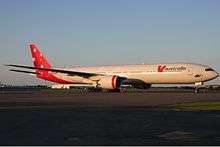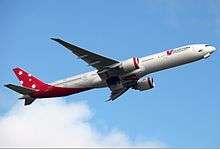V Australia
 | |||||||
| |||||||
| Founded | May 26, 2004[1][2] | ||||||
|---|---|---|---|---|---|---|---|
| Commenced operations | February 27, 2009 | ||||||
| Ceased operations | December 7, 2011 (flights rebranded), December 18, 2014 (deregistered) | ||||||
| Hubs | Sydney Airport | ||||||
| Frequent-flyer program | Velocity Frequent Flyer | ||||||
| Fleet size | 5 | ||||||
| Destinations | 5 | ||||||
| Company slogan | Everyday A New Idea Takes Off | ||||||
| Parent company | Virgin Australia Holdings Limited | ||||||
| Headquarters | Brisbane, Queensland, Australia | ||||||
| Key people |
| ||||||
| Website |
www | ||||||
V Australia Airlines PTY LTD was a long-haul international airline owned by Virgin Australia Holdings.[3]
On 4 May 2011, parent company Virgin Blue announced the rebranding of all of its services (including V Australia and Pacific Blue Airlines) under the new brand Virgin Australia.[4] On 7 December 2011 it ceased to operate under the V Australia name.
History
Naming competition

The name of Virgin Blue's international airline was decided in the same way that Virgin Blue's own name was found, with a public naming competition conducted in early June 2007.
On 25 June 2007, Virgin Blue released the 8 finalists of the naming competition. They were:
- Matilda Blue
- V Australia Airlines
- Australia Blue
- Virgin Pacific
- Amelia Blue
- Didgeree Blue
- Liberty Blue
- Virgin Australia
Australia Blue and Virgin Pacific were early favourites to win the competition, despite a problem with the latter, as Singapore Airlines (through its stake in Virgin Atlantic) has control over the use of the 'Virgin' name on International air routes, and had not, in the past, allowed its use (see Pacific Blue Airlines.)
On 25 July 2007, Virgin Blue announced that V Australia would be the name of the new carrier, with the runner up of the competition, Didgeree Blue, to be the name of the airline's first plane.[5]
Creation
In early 2006, Virgin Blue announced its intention to operate up to seven flights a week to the U.S. through either Los Angeles International Airport or San Francisco International Airport, saying that the route was needed to make the airline as profitable as possible. The airline was given permission for ten flights a week to the U.S. by Australian regulators on 24 July 2007. The plans were approved by US regulators on 15 February 2008, due to the signing of an open skies agreement between Australia and the US.[6] V Australia has since been allowed unlimited capacity between Australia and the U.S. by the Australian International Air Services Commission.[7]
Since then, V Australia applied to the United States Department of Transportation to operate services to and from Sydney Airport to Los Angeles International Airport, San Francisco International Airport, Seattle-Tacoma International Airport, McCarran International Airport (Las Vegas), and John F. Kennedy International Airport (New York City). Permission from the United States Department of Transportation was given after the signing of the open skies agreement.[6]
First aircraft

V Australia placed orders with Boeing to purchase six Boeing 777-300ER aircraft for use on international routes.[8] Pending delivery of the six aircraft, V Australia leased its first Boeing 777-300ER from the International Lease Finance Corporation; named Didgeree Blue, it was delivered to V Australia in Seattle at Boeing's headquarters on 26 January 2009. On 9 February Didgeree Blue touched down at Sydney Kingsford-Smith Airport after flying from Seattle via Los Angeles where it was launched to the U. S. press by Sir Richard Branson and Australian celebrities Julian McMahon and Holly Valance.[9] In 2010 two of the Boeing 777 orders were converted to options for delivery in 2012.[10]
V Australia commenced passenger services on 27 February 2009.[11] On 17 August 2009, V Australia announced that it would expand on its Brisbane/Sydney to Los Angeles routes. It was announced that the airline would fly from Melbourne to Johannesburg, Los Angeles and Phuket, Thailand; as well as Brisbane to Phuket.[12] V Australia also announced on 17 August 2009 that it had applied to fly between Australia and Fiji.[12] V Australia also considered routes to China, according to an interview with Sir Richard Branson.[13]
On 26 August 2010 it was announced that due the unprofitability of some routes, V Australia would cease its 777-300ER services to Johannesburg and Phuket.[14] On 24 February 2011, the aircraft were redeployed on services between Sydney and Abu Dhabi to coincide with the partnership between V Australia and Etihad Airways.[15]
Destinations
V Australia had served the following destinations prior to being absorbed into Virgin Australia in December 2011.
- Australia
- Brisbane - Brisbane Airport
- Melbourne - Melbourne Airport
- Sydney - Sydney Airport [Base]
- United Arab Emirates
- United States
Terminated destinations
Before V Australia was absorbed into Virgin Australia, it previously served Johannesburg,[16] Phuket [16] and Nadi.[17]
Codeshare & interline agreements
V Australia had interline agreements with Alaska Airlines to Seattle–Tacoma International Airport;[18] Delta Air Lines;[19] and Horizon Air to Portland International Airport. It was announced on 26 August 2010 that V Australia had signed a codeshare and interline agreement with Middle Eastern carrier Etihad Airlines, giving Virgin passengers access to 65 destinations in Europe and the Middle East.[20]
Within Virgin-branded airlines V Australia offered codeshare services with Virgin Australia throughout its network in Oceania, and to and from New Zealand with Pacific Blue Airlines. V Australia also had an interline agreement with Virgin America to Boston, Las Vegas, San Francisco, New York City, Seattle and Washington DC.[21] Virgin America and V Australia shared terminal facilities at Los Angeles International Airport's Terminal 3; inbound V Australia flights used to arrive at the Tom Bradley International Terminal, as of November 2011 inbound flights arrive at Terminal 5. All V Australia connections were through Los Angeles International Airport. U.S. interline passengers were transferred onto V Australia to a destination within Australia.
Fleet

In September 2011, the V Australia fleet consisted of the following aircraft:[22]
| Aircraft | In Fleet | Passengers | |||
|---|---|---|---|---|---|
| J | P | Y | Total | ||
| Boeing 777-300ER | 5 | 33 | 40 | 280 | 353 |
Services
Cabin classes
V Australia offered a 3-class service on its Boeing 777-300ER aircraft: International Business Class, International Premium Economy Class and International Economy Class. All three classes featured ambient Mood Lighting relative to the time of day or night, similar to that of sister airline Virgin America.
International Business Class International Business class[23] had a 2-3-2 configuration with fully horizontal flat beds that are 188 cm (6'2") long and seat pitch of 77". There was a personal workstation with laptop power, USB slot and reading light. Business Class In-Flight entertainment had a 12.1" touchscreen PTV with AVOD on every seat.
International Premium Economy Class Premium Economy class[24] had a 2-4-2 configuration. Premium Economy had all-leather seats with a 38" seat pitch, 20" seat width and a 9" seat recline. The seats were equipped with adjustable headrests and footrests. There was a personal workstation with laptop power, USB slot and reading light. Premium Economy class In-Flight entertainment had a 10.6" touchscreen PTV with AVOD on every seat.

International Economy Class International Economy class[25] had a 3-3-3 configuration. Economy seats had a 32" seat pitch, 18.8" seat width and seat recline of up to 6". USB slots were available to power laptops and other personal devices (MP3 Players etc.). Economy class In-Flight entertainment had a 9" touchscreen PTV with AVOD on every seat.
In-flight entertainment
V Australia's In-Flight entertainment RED was based on the Panasonic eX2 system. RED was fully touch-screen and handset controlled and there was no fee for use. It featured an extensive video on demand library that included new release film, TV series and TV programmes. Destination guides were also available. Other functions available through RED included music on demand (approx 200+ CD library) and video games. Seat-to-seat chat was available as well as in flight map and flight information.
Lounge access
Lounge access was available when flying V Australia for International Business Class passengers and Velocity Gold members only. Velocity Gold allowed access regardless of class of travel.
Both V Australia Business Class and Premium Economy Class passengers connecting to V Australia on Virgin Australia flights domestically within Australia were entitled to access Virgin Australia's domestic lounges on the day of travel.
At the time services ceased, V Australia used Air New Zealand's Koru Lounge in Sydney, Melbourne and Brisbane; Alaska Airlines' Board Room lounge in Los Angeles (Terminal 3) and Etihad Airways' Lounge in Abu Dhabi.
References
- ↑ "Historical details for ABN 52 109 260 451". abr.business.gov.au. Retrieved 16 April 2015.
- ↑ "V AUSTRALIA AIRLINES PTY LTD ACN 109 260 451". connectonline.asic.gov.au. Retrieved 16 April 2015.
- ↑ V Australia To Begin Service 4Q 2008
- ↑ Virgin Blue Rebrands as Virgin Australia :: Routesonline
- ↑ Virgin Unveils New Transpacific Airline
- 1 2 Virgin Blue signs up for open skies to the US
- ↑ Bird, Michael (1 August 2008). "Determination [2008] IASC 110" (PDF). Australian Government - International Air Services Commission. Archived from the original (PDF) on 19 May 2009. Retrieved 10 February 2009.
- ↑ Virgin Blue Orders Boeing 777-300ERs to Initiate Long-Haul Service
- ↑ "First V Australia Boeing 777 Arrives in Sydney Plus More Aviation News". PopSci.com.au. 9 February 2009. Retrieved 2009-02-09.
- ↑ Thomas, Geoffrey. "Virgin Blue converts two firm 777-300ERs to options", Air Transport World retrieved 5 September 2011
- ↑ "Australia's New International Airline Takes Off" (Press release). V Australia. 27 February 2009. Retrieved 27 February 2009.
- 1 2 "V Australia Launches New Routes". PopSci.com.au. 17 August 2009. Retrieved 2009-08-17.
- ↑ July/Aug 2009 official newsletter of the British Chamber of Commerce [Shanghai]
- ↑ V Australia > Media Releases
- ↑ V Australia > Media Releases
- 1 2 Virgin Australia (2010-08-26). "The Virgin Blue Group Announces Second Phase of Network Review". Retrieved 2011-08-30.
- ↑ "Virgin Blue may cut routes and brands". The Age. 2010-06-03. Retrieved 2011-08-30.
- ↑ Release to the Australian Stock Exchange - V Australia announces SYD-LAX as launch route
- ↑ V Australia and Delta sign agreement Archived 27 March 2009 at the Wayback Machine.
- ↑ O'sullivan, Matt (26 August 2010). "Virgin tie-up with Etihad a blow to Qantas". The Sydney Morning Herald.
- ↑ < V AUSTRALIA AND VIRGIN AMERICA SIGN INTERLINE AGREEMENT
- ↑ Australian civil aircraft register search, using "Virgin Australia International Airlines" as the search parameter. Search conducted 5 September 2011.
- ↑ International Business Class
- ↑ International Premium Economy Class
- ↑ International Economy Class
External links
| Wikimedia Commons has media related to V Australia. |